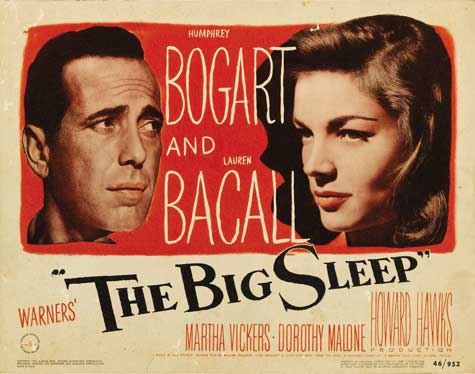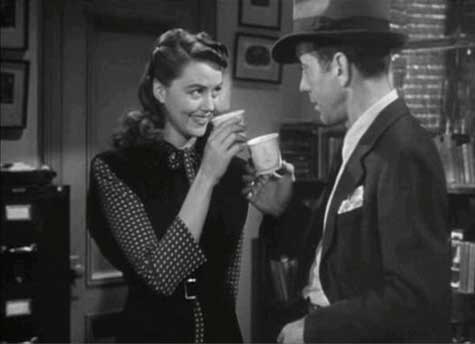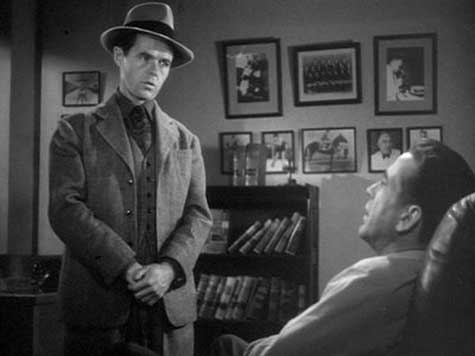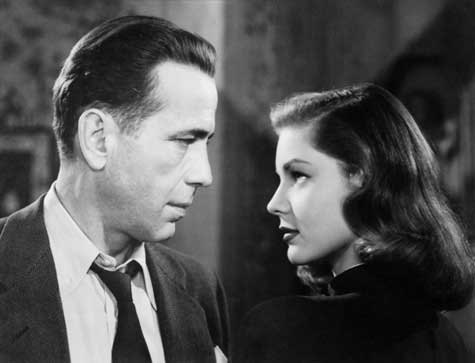
In tribute to the late Lauren Bacall, we’re looking at the four classic films she made with husband and screen partner Humphrey Bogart between 1944 and 1948: To Have and Have Not, The Big Sleep, Dark Passage, and Key Largo. Last week we looked at Howard Hawks’ To Have and Have Not. Today we’ll look at Hawks’ The Big Sleep.
The Big Sleep is a movie that is nearly universally beloved by movie buffs, but it is also the source of some debate among noir fans. Everyone agrees that it’s masterfully made, and everyone agrees that it contains one of Bogart’s great performances. But is it noir? Many people say no. One must admit, too, that there are strong arguments in support of this argument.
The film is Howard Hawks’ adaption of the novel by Raymond Chandler, with a screenplay written by an impressive threesome: William Faulkner, Leigh Brackett, and Jules Furthman—with additional work by Hawks himself. It tells the story of private detective Philip Marlowe (Bogart), hired by General Sternwood (Charles Waldron) to deal with a blackmailer. The General has two daughters. One, Vivian (Lauren Bacall), is very pretty and somewhat shady. The other, Carmen (Martha Vickers), is very pretty and totally nuts. Marlowe has to track down the man trying to blackmail Carmen over some gambling debts, but before he can find the man, the man ends up dead, with Carmen “higher than a kite” and sitting in the same room. This is, as they say, just the beginning as Marlowe is led deeper and deeper into the Los Angeles underworld.

Chandler’s plot is famously labyrinthine, but as the man himself once said, a good mystery is the kind where you don’t have to read the end to be satisfied. It’s all about the journey, the descent into the world that springs up after dark. Marlowe comes into contact with an assortment of weird characters: the foppish blackmailer and his overly devoted chauffer, a gangster named Eddie Mars (John Ridgely) and his cold-blooded henchman Canino (Bob Steele), and a “funny little guy” named Harry Jones (Elisha Cook Jr.) who helps Marlowe after he gets worked over by a couple of goons. Most people can’t sum up the plot because each scene is about itself, not the plot. Take the scene where Marlowe meets and spends a rainy afternoon with a sexy girl (Dorothy Malone) in a bookstore. This scene was included, Hawks said, just because “the girl was so damn pretty.” Everything ties together thematically and tonally, but to attempt to untangle the plot is pointless. Hawks doesn’t even use the final scene to resolve the plot; he uses it to strike an ending note. It’s the tone that matters here, and it’s the tone that you take with you. The Big Sleep is a triumph of acting, editing, directing, cinematography, and scoring. It is—very nearly—a perfect studio film.

But is it noir? The debate over The Big Sleep goes back to the question of tone. To begin with, Raymond Chandler set out to create a hero when he created Marlowe. He set out to create a tarnished knight in the American idiom (in a scene from his novel which was not included in the movie, Marlowe stares at a painting of a knight rescuing a lady and remarks that if he owned the painting he would “sooner or later have to climb up there and help”). Chandler succeeded to such an extent that Marlowe became archetypal, the world-weary private eye with his fedora and cigarette and wisecracks. But noir—at least as most of us understand it—is about weakness, fear, and isolation. Chandler’s tarnished knight descends into the lower depths, but he remains a knight—or as Chandler himself wrote, Marlowe remains “puzzled, but never quite defeated.”
One would be hard pressed to find a better director for that worldview than Howard Hawks. Generally considered one of the best American directors (Orson Welles called him “certainly the most talented”), Hawks was a man whose worldview was that of a professional. Get in, get the job done. Don’t complain. Handle the situation. In a time when most producers were under contract at studios, Hawks was a free agent. His movies almost always made money and got good reviews. He worked in every genre, with most of Hollywood’s major stars. He seized on The Big Sleep as a vehicle for Bogart and Bacall, both of whom he had just directed to enormous success in To Have And Have Not. He saw in Chandler’s novel the makings of a good mystery and a good romance for his stars. Hawks knew that everyone wanted to see Bogart kill the bad guy and kiss Bacall as triumphant music kicked up for the slow fade out.
Noir, however, is about being defeated. Noir is about antiheroes, weak men who go bad and get sent straight to hell for their transgressions. It’s not about knights, tarnished or otherwise. Some people have commented that The Big Sleep plays like a Howard Hawks protagonist got lost in the world of film noir.
There’s something to this argument. Bogart’s Philip Marlowe is a can-do guy. Like most Hawksian heroes he is the strongest, smartest, most capable man in his world. Though Bacall is less saucy than she was in To Have And Have Not, her Vivian Sternwood is smarter, stronger, and wittier than her inspiration in the Chandler novel. Thus, this film is very much a Howard Hawks take on the material.

But the argument that The Big Sleep is not a film noir is a little overstated. For one thing, Bogart undergoes a subtle transformation in the course of the film. In the opening half of the picture, he’s very much the wisecracking tarnished knight. But as the film goes along, Bogart undergoes a gradual disintegration. Watch the scene of him awaiting Bacall’s phone call just before the scene in Joe Brody’s apartment. He’s pacing, nervous, rubbing his hands together. When he answers the phone, his voice is just a bit high and it cracks a little. He’s falling in love with this shady woman, and he doesn’t want to. Then consider the scene where he drops a bullet while loading a gun in preparation for his showdown with the gangster Eddie Mars. “You’re the one who’s shaking now,” Bacall says. Bogart replies, “I’m scared, angel.” Or look at the final confrontation with Eddie Mars. Bogart’s eyes flair up, and he’s clearly enjoying torturing Eddie Mars, sending the gangster to his death in a hail of bullets. Watching his face, you can see the seeds of Bogart’s dark turn in 1950’s In A Lonely Place where the fear and bluster gave way to paranoia and sadism. Bogart was a major movie star, one of Hollywood’s greatest icons. He’s bigger than any one genre, but watch The Big Sleep again. You can see him enter Noirville. Yes, he does emerge triumphant, but this place takes its toll on him. He won’t withstand its effects forever.
Postscript #1: The Big Sleep was originally filmed in the fall of 1944, but it wasn’t released until 1946. The reason for this was twofold: one, Warner Brothers wanted to rush into release its backlog of war films before WWII came to an end; and two, the studio wanted to re-edit the film—and add new scenes—in order to play up Bacall’s character and the central romance. The original unseen 1945 version is often included on DVDs as an extra to the 1946 version, and it is well worth watching. For one thing, it makes The Big Sleep even more of a film noir. There are many more scenes of Marlowe doing detective work (searching a murder victim’s house, talking to the cops), and his relationship with Bacall is condensed and more coldly antagonistic. In short, the 1945 version isolates him more and thus hues closer to both the lonely private eye that Chandler envisioned and the capable professional that Hawks preferred. The ‘46 version is the better movie—faster, funnier, and sexier—but the ‘45 version is darker and clearer in terms of the plot.
Postscript #2: The plot of The Big Sleepis often referred to as incomprehensible. There is a famous story of Hawks wiring Chandler to inquire about a plot point. Chandler supposedly wired back, “If you don’t know, then neither do I.” I don’t know if this story is true, but if it is true then it says more about Chandler’s famous wit than it does about the plot. The plot is difficult, even convoluted (and, as I said before, it’s not really the point of the picture), but the reports of its impenetrability have been overstated. Here’s a recap of the film’s main plot points:
1. Mars killed Regan and told Vivian that Carmen did it. This is changed from the novel, where we discover that Carmen killed Regan. This change was made, I suspect, to cut the mustard with the censors. In the book, Marlowe lets Carmen be sent away instead turning her over to the cops. The Hays office wouldn’t have let that stand. At the end of the film, Marlowe confronts Mars about killing Regan, and Mars more or less admits to it before he’s killed.
2. Owen Taylor—whom we never see—kills Geiger and steals the undeveloped film of Carmen high on drugs. Taylor loves Carmen and probably means to destroy the film. In the novel, by the way, Carmen was naked in the picture.
3. Joe Brody kills Owen Taylor and takes the film which he then uses to blackmail Carmen.
4. Carol Lundgren, chauffer and implied lover of Geiger, kills Joe Brody. He thinks Brody killed Geiger.
Jake Hinkson, The Night Editor, is the author of The Posthumous Man and Saint Homicide.
Read all posts by Jake Hinkson for Criminal Element.

PS. Great idea for the upcoming 70th anniversary: a theatrical double-bill of the ’45 and ’46 versions.
“Mars killed Regan and told Vivian that Carmen did it.”
You know I’ve seen this film 20 times at least and somehow I never quite got this. I guess it’s because I saw the Mitchum film first, never got confused, then read the novel, never got confused, then saw the Bogart film, and couldn’t make heads or tails of it. Took 6 times before it started to make sense, and that was with me already knowing the plot. The dialogue where Marlowe says, “Tell me how you convinced Vivien that Carmen did it” would seem to suggest that, but it’s so vague it’s hard to be sure. Similarly, the whole business of whether Joe killed Owen or not. It’s so simple in the ’78 film, Owen committed suicide!
I never liked Bacall. If I’d been Marlowe, I’d have gone back to the book store when it was all over.